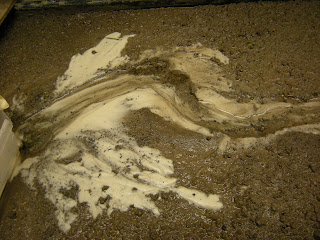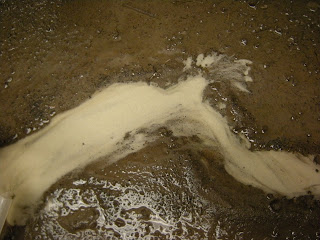3:1 Test
We set up a new stream table test and began it on February 2. We have a 1 degree gradient, cut a small channel into the middle to help start directing the flow, and had out sediment input a 3:1 ratio of sand to mud. We made a new sediment input so it could run longer without adding more sediment. This consisted of a flower box holding the sediment instead of a small tupperware.
Two days later there was an alluvial fan. Even though it was a perfect alluvial fan this is not what we wanted. The water would flow over the alluvial fan with no channel. We thought this might have happend becaue we had too much sand in our sediment.
2:1 Test
We wanted to try a new sediment input so we re-leveled it and set it up the same as at the beginning of our last test (3:1 Test). The only thing we changed was our sediment input ratio. We mixed new sediment so the ratio is now 2:1 sand and mud.
On the 7th another alluvial fan was created. It was slightly different from our first alluvial fan, where as our sediment was sorted and a great floodplain was developed.
2:1 Test
Feb 9, 2011
We kept our table the same today, as in we did not regrade or change anything besides our input. Our input is now 2 mud: 1 sand. We sifted our mud so it would be fine and all of the same size. We used find sand that we purchased, 70 grit.
Immediate results: The finer sediment we used this experiment made it looked like a mud flow for a time. Small channels began to form in our alluvial fan left from the last experiment.
Feb 11, 2011
Our stream made a path to the right of the table and formed an angle at the side and flowed toward the basin from there.















